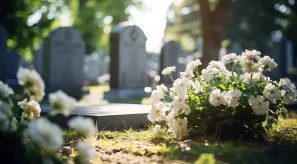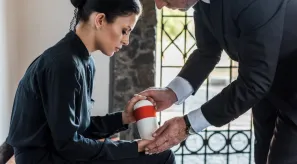There are many different varieties of funerals around the world and they vary from region to region depending on tradition, culture, religion or family customs. At Stelae we will take a look at some of the most interesting and surprising funeral traditions.
Types of funerals around the world based on region
In every part of the world, the types of funeral can vary greatly. The beliefs and values of each country play an essential role in these traditions because they mark how death is understood in every location. What distinguishes the different types of funerals around the world?
Asian funerals: between ritual and spirituality
Asian funerals are strongly influenced by tradition. Although there are many unusual types of funerals in this region, what they all have in common is their solemnity and respect for loved ones, especially the elderly. There is also a focus on the length of time with funerals regularly lasting for three days to honour loved ones who have passed away.
African funerals: a celebration of life
In Africa, the death of a loved one is an occasion to celebrate their life.
Although the rituals can be very varied (take for example an Arab funeral), it is quite common to have a large celebration which includes dancing while carrying the coffin of the deceased.
European funerals: diversity within the conventional
When it comes to funerals, Europe is one of the regions with the greatest cultural variation and tradition. In general, community ceremonies are held in which families remember their loved ones with respect, although the beliefs and culture of each community dictate the type of funeral that takes place.
Funerals in the Americas: ancestral and contemporary cultures
In the Americas there is a wide variety of funeral rituals, both indigenous and those imported from other cultures. Funerals are increasingly common where, once the burial is over, relatives gather at the home of a close relative to eat (mostly sweet things) and drink (but not alcohol).
Funerals in Oceania: respect for nature and roots
As in other regions, the types of funerals in Oceania can vary considerably from island to island and from place to place. However, there are some common aspects, such as the celebration of social events. Burials take precedence over cremation, although the latter is becoming increasingly prevalent, and funeral practices reflect the religious and spiritual beliefs of local communities.
The strangest funerals in the world
In addition to the traditions that are common in every region of the world, there are countless cultural and religious variations in the way each community bids farewell to their deceased loved ones. Below, we take a look at some of the world's strangest funerals, with some intriguing rarities:
Celestial funerals in Tibet
In what are known as Tibetan celestial funerals, the body of the deceased is offered to vultures on top of a mountain. This symbolises the cycle of life and death.
Dancing funerals in Ghana
Funeral rituals in Africa are very diverse. In Ghana, for example, families save throughout their lives to be able to afford the cost of the funeral, which is celebrated with hundreds of guests.
They approach it as a colourful celebration lasting for as long as seven days, with lots of eating, drinking and dancing. The coffins are personalised and the funeral is even advertised on billboards to attract not only family and friends, but also many curious onlookers.
Underwater funerals in Hawaii
For thousands of years, Native Hawaiians practised a form of water cremation that used hot volcanic water to decompose the bodies of the deceased. The remains were buried in the belief that they held the spiritual essence of the soul.
This type of funeral is no longer practised, but in 2022 Hawaii legalised water cremation, which uses a system to speed up the natural process of decomposition of the body. At the end of the process, the remains are incinerated and given to the family, so it is considered an environmentally friendly funeral.
Burials in towers of silence in India
The Parsi, an Indian ethical group, are rooted in the teachings of the prophet Zoroaster. This religion obliges them to be respectful towards the four elements of nature: water, air, earth and fire. This is why they cannot bury or throw their deceased loved ones into the water, nor can they cremate them.
At their funerals, they place their loved ones on top of a tower - which they call Dakhma or Tower of Silence - and let carrion birds devour the bodies of the deceased. The bones are then left to be naturally calcined by the sun's rays.
The mummy ritual in Papua New Guinea
The Dani people, an ethnic minority in the mountains of West Papua, preserve the tradition of embalming in their funeral rites. They do this through fire, using the heat to dry the oil that is poured over the body of the deceased.
After being embalmed, the loved one is preserved by the smoke and animal oil, and the mummy is decorated with boar tusks around the torso and a plume of feathers. In men, the ‘koteka’, a dried gourd, is added to cover the penis.
The deceased is kept mummified in a hut called a ‘honai’, where family members spend the night watching over their loved one. Sadly, it is a tradition that is slowly fading away.



